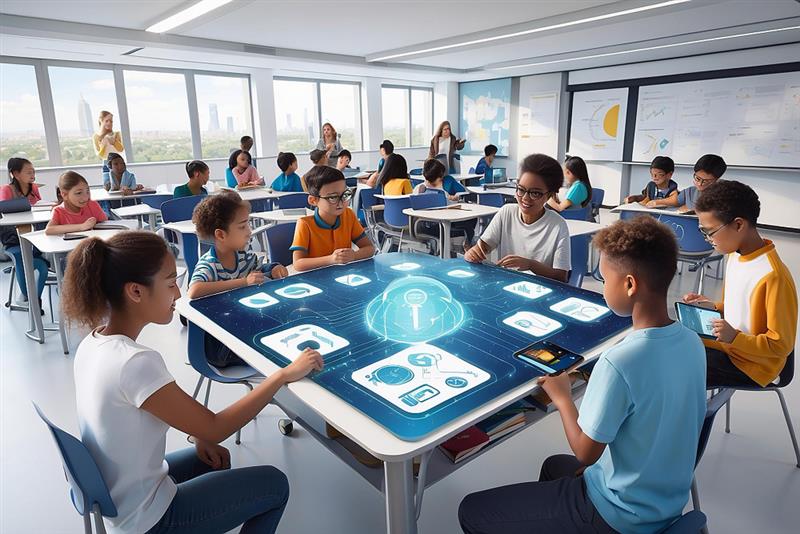A strong leader can change a school. They inspire teachers, motivate students, and create a culture where learning and growth come naturally. Leadership in education is about more than rules or schedules. It’s about setting a standard, building a team, and creating a school where everyone feels encouraged to do their best. In 2025, these leadership practices can help educators make a lasting impact.
Let’s look at six high-impact leadership practices that every educator should master. These practices are practical, realistic, and designed to help educators build stronger and more positive school communities.
Set the Standard with Your Actions
The actions of a leader speak louder than any speech or policy. Teachers, students, and even parents notice how you behave daily. If you want your school community to be punctual, respectful, and hardworking, you must demonstrate these qualities consistently.
For instance, imagine a principal who always arrives early for meetings, greets every staff member warmly, and addresses problems fairly. These small, consistent actions build trust and set a standard for the entire school. Similarly, a teacher who demonstrates curiosity by trying new teaching methods encourages students and colleagues to do the same.
Setting the standard is not only about being professional. It’s about showing empathy, patience, and integrity in everyday situations. For example, when a student struggles with a lesson, taking the time to support them sets an example for teachers on how to approach challenges.
At the end of each week, reflect on whether your actions align with your values. Ask yourself: Did I demonstrate the behaviors I expect from others? Adjust where needed, because consistent actions create credibility.
Turn Teams into Collaborators
No educator succeeds alone. The best ideas often come from teams working together. Turning teams into collaborators requires creating a culture where everyone’s voice is heard and valued.
Start by organizing regular planning sessions where teachers share their experiences, challenges, and ideas. For example, a math department might meet weekly to discuss different teaching strategies, and a language arts team could collaborate on integrating digital storytelling. These discussions not only improve lesson plans but also foster a sense of ownership among teachers.
Leaders can also encourage peer mentoring. Pairing experienced teachers with new educators helps transfer knowledge while creating strong bonds within the team. When staff members feel trusted and included in decision-making, collaboration naturally leads to innovation.
Creating a collaborative environment also means allowing room for mistakes. Encourage teachers to experiment with new approaches and support them if results are not perfect. Collaboration thrives when people feel safe to take risks.
Use both in-person and digital tools for collaboration. Tools like shared lesson planning platforms or communication apps help teachers stay connected and engaged, especially in hybrid learning environments.
Make Vision Your North Star
A clear vision guides every decision a school makes. Without a vision, even the most skilled educators can feel directionless. A strong vision goes beyond test scores or rankings. It defines the kind of learning environment the school wants to create.
To make vision meaningful, involve your staff in shaping it. Ask questions like: What values should guide our teaching? How do we want students to feel about learning? Involving teachers in this process ensures that the vision reflects the community’s goals, not just one person’s ideas.
Once your vision is set, communicate it regularly. Remind staff how their daily work contributes to larger goals. For instance, if the vision emphasizes creativity, show how a new project or lesson plan reflects this. When teachers understand their role in achieving the school’s vision, they feel more motivated and invested.
Vision also helps guide your team through challenges. During transitions, such as adapting to new technology or addressing learning gaps, reminding everyone of the bigger purpose provides stability and direction. Make your vision actionable and relatable. Link it to real classroom activities, staff projects, and student initiatives so everyone sees how it comes alive each day.
Build a Learning Culture
Learning should never stop in schools. A culture of continuous learning keeps both teachers and students engaged, adaptable, and ready for the future. Educational leadership practices that emphasize learning create schools that stay innovative and effective. UNESCO’s 2024–2025 Global Education Monitoring Report highlights that strong education leadership and investments in principal and teacher training are crucial for quality improvement in schools worldwide.
Encourage teachers to attend workshops, conferences, and professional development programs. Organize regular peer-learning sessions where staff can share new strategies or teaching tools. For example, a science department might showcase a successful hands-on experiment, inspiring other teachers to try it.
Leaders should also model a growth mindset themselves. When principals try a new digital tool or enroll in a course, it sends a clear message: learning is for everyone. This approach encourages teachers to experiment, adapt, and grow without fear of failure.
A learning culture is not just formal training. It includes encouraging curiosity in small ways: trying a new lesson plan, exploring technology, or reading educational research. Over time, these habits help create a school environment where continuous improvement is natural. Introduce micro-learning opportunities. Short, focused sessions—like a 20-minute workshop on classroom tech or peer feedback—allow teachers to grow without adding stress to their schedules.
Celebrate the Wins That Matter
Recognition is a simple but powerful motivator. Celebrating progress—big or small—reinforces positive behavior and inspires continued effort.
Effective leaders recognize achievements that align with the school’s goals. This could include a teacher successfully introducing project-based learning, a student team completing a community project, or improved collaboration between departments. Highlighting these wins shows that effort and progress are valued.
Celebration doesn’t always have to be formal. A shout-out in a staff meeting, a thank-you note, or a post on the school’s communication platform can make people feel appreciated. When teachers and students see their contributions acknowledged, they are more motivated to keep improving.
Make recognition personal. Share the story behind the success, not just the outcome. Explain why the achievement matters and how it impacts the school community.
Create a Culture Where People Thrive
A school’s culture determines how teachers, staff, and students feel every day. Leaders play a key role in creating an environment where people feel safe, supported, and valued.
Start by promoting open communication. Encourage teachers to share concerns, ideas, and feedback. Address challenges fairly and consistently. Foster inclusivity by celebrating diverse perspectives and experiences within the school.
Support mental health and well-being. Teachers and students are more productive and creative when they feel cared for. For example, organize staff wellness programs, provide counseling resources, or create flexible schedules during stressful periods. Recent studies estimate as many as 52% of educators report feeling burned out, with over one-quarter experiencing symptoms of depression and anxiety, highlighting urgent leadership actions to prioritize well-being.
It is important to encourage experimentation without fear of failure. When people feel safe to make mistakes, they’re more open to trying new ideas and finding better ways to grow. Leaders who combine guidance with support create a culture of resilience and motivation.
Recognize that small daily actions matter. Listening, showing empathy, and being fair in decision-making contribute more to a thriving school culture than policies alone.
Conclusion
In 2025, educational leadership is about action and example. When educators focus on setting standards, collaborating, sharing a clear vision, learning continuously, recognizing wins, and fostering a positive culture, their schools can achieve real success.
These leadership practices are not quick fixes. They are habits that build schools where both teachers and students thrive. Leadership in education is more about inspiring people to grow, achieve, and believe in their potential than management.









